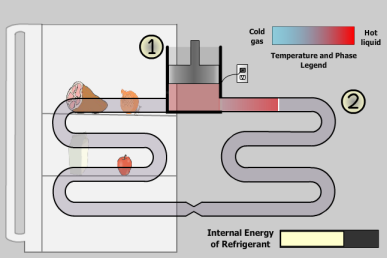
In the Refrigeration Learning Tool., the refrigerant is first compressed by a piston; we say that the compressor has performed work on the refrigerant.The refrigerant flowing through the refrigerator in the Refrigeration learning tool Work is one way of transferring energy. The compressor in a refrigerator converts electrical energy supplied by an external source (the refrigerator is plugged into an electrical socket) into the kinetic energy of the piston. This energy is then transferred to the system as work. Because work is performed on the refrigerant, the refrigerant’s internal energy (and temperature) increases.
As the refrigerant is being compressed, it flows into the condenser (the coil on the right). In the condenser, the refrigerant releases energy to the surroundings. In this case, the immediate surroundings are the air outside the refrigerator. However, the energy is not transferred as work, but as heat. The refrigerant releases heat by condensing (how condensation releases heat will be fully discussed in Key Idea 5: Energy and Phase Changes). Because the refrigerant has been defined as the system, we say that the system has released heat to the surroundings, which causes the internal energy of the system to fall. This energy transfer occurs because of a temperature difference between the surrounding air and the refrigerant fluid, it is due to this difference that we refer to it as an act of heating.
Next, the refrigerant passes through an expansion valve. In the expansion valve, the pressure exerted on the refrigerant decreases sharply, causing it to expand and its temperature to decrease. This prepares the refrigerant to absorb energy within the evaporator.